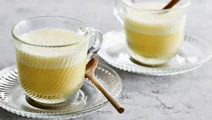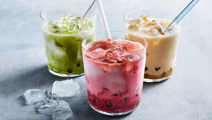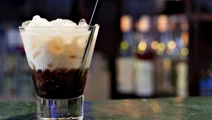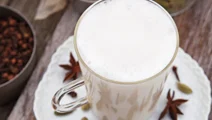Elderflower cordial

Elderflower cordial is the essence of late spring and early summer, captured in a bottle. The tiny elderflower blossoms may be small, but they hold an incredible amount of flavour, ready to be transformed into a refreshing and fragrant syrup. We throw in some lemons, too, bringing a bright, citrusy note. Ready to make refreshing elderflower drinks?
Ingredients
|
Water
|
2 l |
|---|---|
|
Sugar
|
1½ kilo |
|
Elderflowers heads
|
50 g |
|
Lemons (unwaxed)
|
4 |
|
Citric acid
|
4 tsp |
Instructions
Recommended information
Serving suggestion
Harvest elderflowers at their best
To make your elderflower cordial taste great, pick elderflowers on a sunny day before the midday heat. They usually peak in late May and June, depending on the weather. Choose fresh, fully opened clusters with creamy-white blossoms, as these will have the best fragrance and taste. Use them as soon as possible after picking them to preserve their aroma. Avoid flowers that are starting to turn brown, as they can give the cordial a bitter taste.
Balance sweetness and acidity
The balance of sweetness and acidity is key to a tasty elderflower cordial. Sugar provides sweetness, while citric acid brings tanginess that makes the floral flavours shine. To make a less sweet cordial, reduce the sugar slightly. For a sharper taste, add a little more citric acid. The mixture will develop over time, so tasting it before straining helps you adjust the flavours to your liking.
Sterilise your bottles
Clean bottles mean your elderflower cordial stays fresh for longer. Wash them with hot, soapy water, give them a good rinse, and then pop them in the oven at 120 °C for about 15 minutes or dip them in boiling water for a few minutes. Let the bottles cool slightly before filling them.
FAQ: Questions about elderflower cordial
Is it your first time making elderflower cordial? Then you might have a few questions about storage, serving, or what to do if the colour is not quite what you expected. Here is everything you need to know.
What is elderflower cordial?
Elderflower cordial is a syrup made by infusing elderflowers in a sugar solution with lemons and citric acid. It is especially popular across the UK, Scandinavia, and Central Europe, where elder trees grow abundantly in hedgerows and woodlands. The cordial is typically diluted with water before drinking and is also used in jams, desserts, and baking.
What does elderflower cordial taste like?
Elderflower cordial has a light, floral taste with a hint of citrus. It is also sweet and fragrant, with a hint of honey and a fresh, summery feel. The lemons add a bit of tang, keeping it bright and refreshing. Its delicate flavour is often compared to lychee, pear, or white grape juice.
How long does homemade elderflower cordial last?
Homemade elderflower cordial lasts for about 4–6 weeks in the fridge. Since our recipe does not heat-process the cordial after straining, it must always be kept chilled. When stored in sterilised bottles, it stays fresh for this period, but once opened, it should be used within 2–3 weeks to maintain its flavour.
Can you freeze elderflower cordial?
Of course! Freezing is a great way to make it last longer. Pour it into ice cube trays or freezer-safe containers, leaving some room for expansion as it freezes. When needed, just defrost the amount you want. You can even freeze it in ice lolly moulds for a refreshing summer treat.
How can I serve elderflower cordial?
Elderflower cordial is best enjoyed diluted with cold or sparkling water in a ratio of 1 part cordial to 4 parts water, though you can adjust it depending on the taste you prefer. It can also be drizzled over fruit salads, stirred into yoghurt, or used in homemade ice lollies. For a touch of botanical-like sweetness, try adding it to cakes, glazes, or salad dressings.
Why is my elderflower cordial brown?
There are a few reasons why elderflower cordial can turn brown. The flowers may have been past their best when picked, left too long before using, or exposed to too much heat while making it. Browning can also happen if the mixture is left uncovered or stored in direct sunlight. To keep your cordial pale and fragrant, use freshly picked elderflowers, store them in a cool place, and always cover the mixture while it rests.
Nutritional values
Nutritional value, per
6321 Kcal
| Fibre | 29.4 gram fibers |
| Protein | 5.5 gram |
| Carbohydrates | 1541 gram |
| Fat | 4.2 gram |
Homemade elderflower cordial
If late spring and early summer had one flavour, we would point straight at elderflower! Elderflower cordial is a must when the flowers are in bloom, and what makes it even better is that you can turn it into a family activity. Everything tastes sweeter when made together, so grab your loved ones, pick the blossoms, and get started on this refreshing drink.
Floral sweetness with zesty citrus
Elderflowers and lemons are like a match made in heaven. One is delicate and floral, the other tart and citrusy, and together, they unite to create a refreshing balance of light sweetness and bright tanginess. Sugar draws out the elderflower’s natural sweetness, while citric acid sharpens the lemons’ tang, making the flavours even more vibrant and refreshing.
Enjoy fragrant and refreshing drinks
Our easy elderflower cordial recipe was made for laid-back summer sipping, and there are so many ways to enjoy it. Mix it with sparkling water for a light and fizzy refresher, or blend it with grape or apple juice for a fruitier option.
Feeling creative? Add a splash to homemade lemon iced tea, stir it into fresh lemon juice, or muddle it with berries and soda water for a fruity drink. You can even blend it with ice and frozen mango or peaches for a refreshing slush.
And if you have saved some for later in the freezer, do not forget that elderflower cordial is just as lovely when the skies turn grey. Stir it into hot water with a slice of lemon for a soothing winter drink, and let it bring a little taste of summer to the colder months.
Use for tasty dessert treats
Who says elderflower cordial is only for drinks? You can turn it into a delicate jelly layer for panna cotta, cheesecakes, or silky mousses. It would be right at home on our white chocolate cheesecake, adding a light finish on top.
Stir it into whipped cream for a fragrant filling, swirl it through homemade vanilla ice cream, or brush it over sponge cakes to keep them moist. You can even liven up a classic courgette cake by adding the cordial to the cream cheese frosting.
If you have any fresh elderflower blossoms left, use them as a stunning garnish. Their tiny, creamy-white blooms are not just gorgeous to look at; they are also completely edible and add a lovely touch to any dessert. With their light floral sweetness and subtle hints of honey and pear, they taste just like elderflower cordial – only in a fresher, more delicate form.
Tweak the recipe
Get creative with our recipe for elderflower cordial – we even have a few ideas to get you started. Add a few mint leaves for a cooling freshness or some ginger for punchy, peppery heat. You can also throw in some ripe berries. Strawberries offer a mellow, juicy sweetness, while raspberries take a sharper route with their tart charm.
Swapping some lemon slices for oranges makes the citrus taste sweeter and the cordial feel more well-rounded. And if you want to bring out the floral notes, a pinch of vanilla powder for a warm, smooth sweetness.









